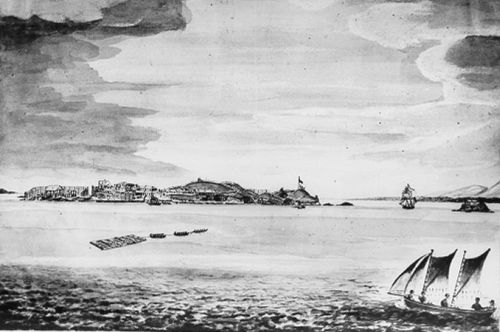 |
 |
|
Thomas James Lempriere
Thomas James Lempriere (1796–1852), commissariat officer, was a member of an old Jersey family dating back thousands of years. His mother and banker father spent years in Hamburg and Calais. The family was interned by Napoleon in 1803, but in 1812 Thomas was repatriated by subterfuge from Verdun with secret despatches. He served the Commissariat Department in France, Flanders and the West Indies (1815–16), then was employed in the counting house of cousins, T&W March & Co, London. Under their auspices, Lempriere sailed for Van Diemen's Land, arriving in Hobart in 1822 to commence his own business. A shipboard romance resulted in his marriage to Charlotte Smith in 1823, and their large family was born over twenty years from 1824. Lempriere was prominent in the development of the Bank of Van Diemen's Land, but his Hobart business failed and by September 1825 he was insolvent. He returned to the Commissariat and served at Maria Island (1826–27), Sarah Island (1827–30), Hobart (1830–33), Port Arthur (1833–48), Oatlands (1848–9) and Hong Kong (1850–2), ultimately rising to the rank of Assistant Commissary-General, the equivalent of an army captain. He was appointed a magistrate in 1838 and a coroner in 1846. Lempriere commenced a first-hand account of the colony's penal settlements in 1837, but this was not published until 1954. He was of note as an artist of sketches, scenic water colours and portraits in oils. At least 135 of his works are in private or state collections. He planned the Port Arthur church, took services there and was a prominent Mason. From his time at Sarah Island, Lempriere collected fish specimens for the marine naturalist, Sir John Richardson, and mammals, birds and insects for William Swainson, to whom he was introduced through a gift of Swainson's Naturalist's Guide. Lempriere formed a museum at Port Arthur in 1837 and kept tidal and meteorological information, and a skate named in his honour (Raja lemprieri) testifies to his scientific interests. Lempriere played the bugle horn and key bugle and was a Francophile and inveterate diarist. He died at Aden. Further reading: ADB 2; T Lempriere, The penal settlement of early Van Diemen's Land, Launceston, 1954; research material by G Lennox in Tasmaniana Library. Geoff Lennox |
Copyright 2006, Centre for Tasmanian Historical Studies |
